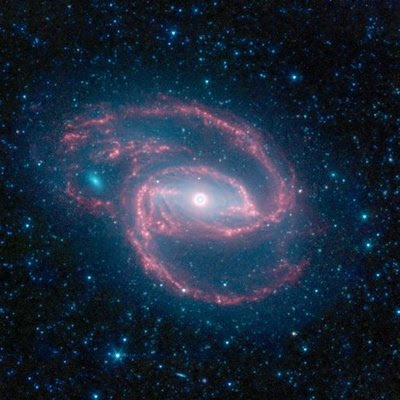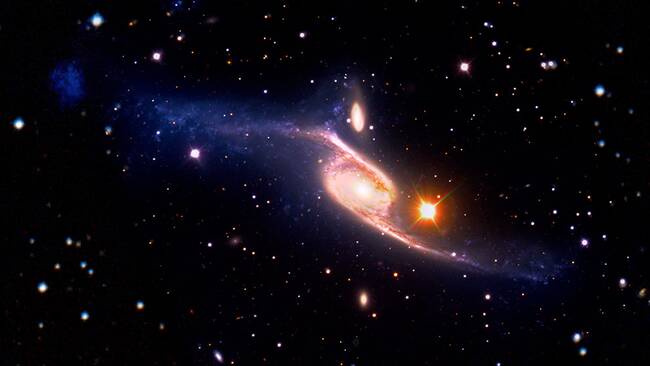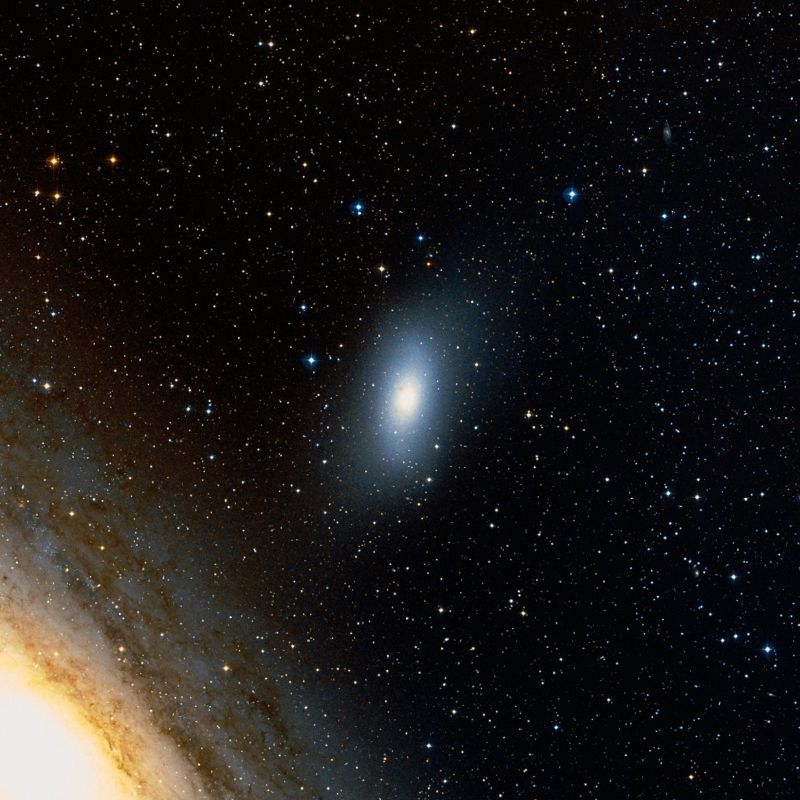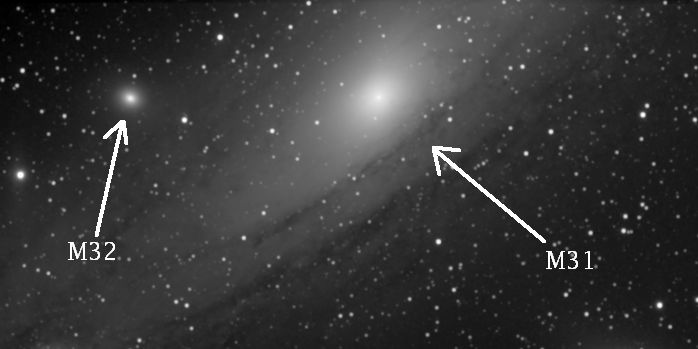Page 1 of 2
APOD: NGC 6872: A Stretched Spiral Galaxy (2016 Apr 26)
Posted: Tue Apr 26, 2016 4:11 am
by APOD Robot
 NGC 6872: A Stretched Spiral Galaxy
Explanation:
NGC 6872: A Stretched Spiral Galaxy
Explanation: What makes this spiral galaxy so long? Measuring over 700,000 light years across from top to bottom,
NGC 6872, also known as the
Condor galaxy, is one of the most elongated
barred spiral galaxies known. The
galaxy's protracted shape likely results from its continuing
collision with the smaller galaxy IC 4970, visible just above center. Of particular interest is
NGC 6872's spiral arm on the upper left, as
pictured here, which exhibits an unusually high amount of
blue star forming regions. The light we see today left these colliding giants before the
days of the dinosaurs, about 300 million years ago.
NGC 6872 is visible with a small
telescope toward the
constellation of the Peacock (
Pavo).
[/b]
Re: APOD: NGC 6872: A Stretched Spiral Galaxy (2016 Apr 26)
Posted: Tue Apr 26, 2016 12:06 pm
by rstevenson
Nice work Judy. One of my favourite galaxies.
Rob
Re: APOD: NGC 6872: A Stretched Spiral Galaxy (2016 Apr 26)
Posted: Tue Apr 26, 2016 12:29 pm
by Ann
Nice image, Geck, really.
But you know me, I can't stop talking color. Sigh.
So my first thought, when I saw this galaxy, was that it looked really very blue. Yet morphologically, it doesn't look as if it should be extraordinarily blue at all. It has a substantial bulge of old stars, and the inner arms have a rich population of old stars, too. Only the extremely elongated outer arms display the clumpy appearance typical of young stars and star formation.
Anyway, I looked up Simbad to check the colors of this galaxy, and I was flabbergasted. If I understand it correctly (and I probably don't), the B-V index of NGC 6872 is something like +0.38, which is frankly extremely blue for a big galaxy. That sort of color index for a galaxy like NGC 6872 can't be right.
But the appearance of NGC 6872 in your picture is strikingly blue. The galactic bulge looks white rather than yellow.
So can you tell me, Geck, if you have used the galactic bulge as a "white point" for the picture of NGC 6872. If the yellow bulge is shown as neutral in color, and the arms are obviously bluer than the bulge, then the overall appearance of NGC 6872 may be very blue indeed.
Or is it true that NGC 6872 is really bursting with young blue stars to the point that it is incredibly blue for a large galaxy?
Ann
Re: APOD: NGC 6872: A Stretched Spiral Galaxy (2016 Apr 26)
Posted: Tue Apr 26, 2016 12:47 pm
by neufer
The galaxy's protracted shape likely results from its continuing collision
with the smaller galaxy IC 4970, visible just above center.
Or.....possibly from its continuing collusion with the smaller galaxy IC 4970.
Re: APOD: NGC 6872: A Stretched Spiral Galaxy (2016 Apr 26)
Posted: Tue Apr 26, 2016 2:01 pm
by Tszabeau
It's seems surprising, to me, that the smaller galaxy is not as distorted as the larger one.
Re: APOD: NGC 6872: A Stretched Spiral Galaxy (2016 Apr 26)
Posted: Tue Apr 26, 2016 2:28 pm
by Asterhole
neufer wrote:
The galaxy's protracted shape likely results from its continuing collision
with the smaller galaxy IC 4970, visible just above center.
Or.....possibly from its continuing collusion with the smaller galaxy IC 4970.
Indeed, there possibly was more than one interaction in the distant past, and probably several more to come in the future.
Re: APOD: NGC 6872: A Stretched Spiral Galaxy (2016 Apr 26)
Posted: Tue Apr 26, 2016 3:02 pm
by Fred the Cat
Tszabeau wrote:It's seems surprising, to me, that the smaller galaxy is not as distorted as the larger one.
https://arxiv.org/pdf/astro-ph/0701291v1
"We have used simulations to investigate the evolution of gas and
stars in such a close encounter, examine the influence of the dark
matter halo and of the geometry of the collision on the characteristics
of the tidal tails and place constraints on the dynamical
history of the observed system."
That doesn't speak to the disruption of IC 4970 but
N-body simulations appear to suggest the geometry of the interaction and dark matter halos could have
colluded to play their part as Art nefariously pointed out.

Re: APOD: NGC 6872: A Stretched Spiral Galaxy (2016 Apr 26)
Posted: Tue Apr 26, 2016 3:40 pm
by ShaileshS
I'm wondering - is the upper arm really blue (young hot star formation region) or it's similar to other arm and it's just that maybe lack of solid/many dust lanes are causing the perception as if that arm is uncharacteristically extra blue ..
Re: APOD: NGC 6872: A Stretched Spiral Galaxy (2016 Apr 26)
Posted: Tue Apr 26, 2016 4:20 pm
by EricD
Interesting to me that those bright blue stars do not last that long. At the distance of 300 million light years, all those stars have died - even before their light reaches us.
Life is short! Make good use of your 100 million years! Call your mom!
Re: APOD: NGC 6872: A Stretched Spiral Galaxy (2016 Apr 26)
Posted: Tue Apr 26, 2016 4:25 pm
by Ann
ShaileshS wrote:I'm wondering - is the upper arm really blue (young hot star formation region) or it's similar to other arm and it's just that maybe lack of solid/many dust lanes are causing the perception as if that arm is uncharacteristically extra blue ..
NGC 6872. Credit:
NASA's Goddard Space Flight Center/ESO/JPL-Caltech/DSS
Both outer arms
are blue. Quite blue, in fact. Take a look at the picture at left. It is a composite image, where blue corresponds to far-ultraviolet light, emanated by very hot sources. The simplest explanation is that the outer arms of NGC 6872 are dominated by very hot stars and highly excited gas. The upper left arm does indeed seem to be bluer than the lower right arm.
But the bright parts of the galaxy are yellow. According to Principal Galaxy Catalog, the B-V index of NGC 6872 is 0.92. That's red for a spiral galaxy, just as red as the Andromeda galaxy, although not as red as M81 (0.95).
I'm not surprised at the overall red color of NGC 6872. The brightness distribution and apparent stellar populations of NGC 6872 sure make it look red.
Ann
Re: APOD: NGC 6872: A Stretched Spiral Galaxy (2016 Apr 26)
Posted: Tue Apr 26, 2016 4:40 pm
by Tszabeau
Asterhole wrote:neufer wrote:
The galaxy's protracted shape likely results from its continuing collision
with the smaller galaxy IC 4970, visible just above center.
Or.....possibly from its continuing collusion with the smaller galaxy IC 4970.
Indeed, there possibly was more than one interaction in the distant past, and probably several more to come in the future.
Thanks. After reading both those articles, I'm still scratching my head and chin a-might. Apparently the galaxies are, currently, in retrograde orbits and the smaller one is knotted tighter due to it's higher ratio of dark matter to matter than the larger one?
Re: APOD: NGC 6872: A Stretched Spiral Galaxy (2016 Apr 26)
Posted: Tue Apr 26, 2016 4:45 pm
by Tszabeau
Fred the Cat wrote:Tszabeau wrote:It's seems surprising, to me, that the smaller galaxy is not as distorted as the larger one.
https://arxiv.org/pdf/astro-ph/0701291v1
"We have used simulations to investigate the evolution of gas and
stars in such a close encounter, examine the influence of the dark
matter halo and of the geometry of the collision on the characteristics
of the tidal tails and place constraints on the dynamical
history of the observed system."
That doesn't speak to the disruption of IC 4970 but
N-body simulations appear to suggest the geometry of the interaction and dark matter halos could have
colluded to play their part as Art nefariously pointed out.

Oops! I referenced the wrong comment with my previous reply. Sorry 'bout that Fred.
Re: APOD: NGC 6872: A Stretched Spiral Galaxy (2016 Apr 26)
Posted: Tue Apr 26, 2016 5:52 pm
by ems57fcva
The interesting part of this picture for me is the bridge of blue star starting at IC 4970 and initially running downwards and to the left before curving around NGC 6872. I take this (and the disruption of NGC 6872's spiral arms) to indicate that IC 4970 has already made its closest pass to NGC 6872, passing below it from the point of view of this photo. As it did so, and bridge of gas and dust formed running between their cores, like I have seen for many other galaxy encounters. The bridge has become twisted, stretched, and stagnant. Without a flow of new gas into/through it, it has condensed into nebulae and clusters, and that is why it is blue.
I continue to wonder why these bridges form. They are not tidal in origin and do not appear in the current galaxy collision models. I strongly suspect that they are due to dark matter and its properties. Indeed, this may be related to how dark and normal matter are disconnected in the Bullet Cluster. Perhaps the dark matter halos are colliding and forming an plane of added density with then contracts into a line and pulls matter into itself from the galaxies.
Re: APOD: NGC 6872: A Stretched Spiral Galaxy (2016 Apr 26)
Posted: Tue Apr 26, 2016 8:11 pm
by Tekija
Cosmic rack?

Re: APOD: NGC 6872: A Stretched Spiral Galaxy (2016 Apr 26)
Posted: Tue Apr 26, 2016 8:24 pm
by Chris Peterson
ems57fcva wrote:I continue to wonder why these bridges form. They are not tidal in origin and do not appear in the current galaxy collision models.
I'm curious why you say that. Long tidal tails and bridges are extremely common in numerical galaxy collision simulations. What we see in this image looks a lot like many simulations I've seen.
Re: APOD: NGC 6872: A Stretched Spiral Galaxy (2016 Apr 26)
Posted: Tue Apr 26, 2016 8:29 pm
by geckzilla
Ann wrote:But you know me, I can't stop talking color. Sigh.
I expected this, so I came up with some thoughts to add before the APOD went up. Yes, the blue channel was quite bright in the arms and much more details can be seen. So much so that I put some of the B filter into the green channel to make it easier to see. Blue on its own likes to be very dark ... it may be an idiosyncrasy of human vision.
An interesting way to look at astro images to get a better feel for how they are is to view each filter alone in grayscale. Not just interesting, actually. Essential. Maybe astronomers take it for granted that they have such easy access to data in its raw form. Anyway. It reduces the bias your brain's interpretation of color introduces. Here are some minimally processed, north-up frames of what the individual filters captured. When you look at the B filter you will notice so much more detail in the galaxy's outer reaches.
http://www.geckzilla.com/astro/NGC6872_ESO_R.jpg
http://www.geckzilla.com/astro/NGC6872_ESO_V.jpg
http://www.geckzilla.com/astro/NGC6872_ESO_B.jpg
If you combine those three, it looks like this. See how hard the arms are to see? Looking at just the B filter you know they're there, though. I could say I actually made them less blue with my image just to make them easier to see.
http://www.geckzilla.com/astro/NGC6872_ESO_RVB.jpg
Maybe you'll like them, maybe not.
Re: APOD: NGC 6872: A Stretched Spiral Galaxy (2016 Apr 26)
Posted: Tue Apr 26, 2016 10:02 pm
by NGC3314
Those outer features are pretty blue. They're blazingly bright in the UV. There was a GALEX press release, but the only graphic they had (AFAICT) was an optical-UV comparison that didn't make this visually clear. So here's the GALEX UV color image (yellow=near-UV, 2400 A, blue=far-UV at 1500 A). One paper analyzing these results named this system the Condor.
Re: APOD: NGC 6872: A Stretched Spiral Galaxy (2016 Apr 26)
Posted: Tue Apr 26, 2016 10:51 pm
by Ann
geckzilla wrote:Ann wrote:But you know me, I can't stop talking color. Sigh.
I expected this, so I came up with some thoughts to add before the APOD went up. Yes, the blue channel was quite bright in the arms and much more details can be seen. So much so that I put some of the B filter into the green channel to make it easier to see. Blue on its own likes to be very dark ... it may be an idiosyncrasy of human vision.
An interesting way to look at astro images to get a better feel for how they are is to view each filter alone in grayscale. Not just interesting, actually. Essential. Maybe astronomers take it for granted that they have such easy access to data in its raw form. Anyway. It reduces the bias your brain's interpretation of color introduces. Here are some minimally processed, north-up frames of what the individual filters captured. When you look at the B filter you will notice so much more detail in the galaxy's outer reaches.
http://www.geckzilla.com/astro/NGC6872_ESO_R.jpg
http://www.geckzilla.com/astro/NGC6872_ESO_V.jpg
http://www.geckzilla.com/astro/NGC6872_ESO_B.jpg
If you combine those three, it looks like this. See how hard the arms are to see? Looking at just the B filter you know they're there, though. I could say I actually made them less blue with my image just to make them easier to see.
http://www.geckzilla.com/astro/NGC6872_ESO_RVB.jpg
Maybe you'll like them, maybe not.
Thanks, Geck, very interesting. A fascinating difference between the combined minimally processed image and the finished processed image is that the combined minimally processed image is generally darker. The brightness of the core of NGC 6872 stands out, while the bulge is somewhat faint. The inner parts of IC 4970 look interestingly bright too, although their brightness have been enhanced by their rather edge-on perspective. There is a hint of a faintly bluish ring inside the featureless arms of IC 4970.
Thanks again. It is interesting to see what data you have been working with.
Ann
Re: APOD: NGC 6872: A Stretched Spiral Galaxy (2016 Apr 26)
Posted: Tue Apr 26, 2016 11:11 pm
by geckzilla
Ann wrote: A fascinating difference between the combined minimally processed image and the finished processed image is that the combined minimally processed image is generally darker. The brightness of the core of NGC 6872 stands out, while the bulge is somewhat faint.
Yeah, I always start with very dark images so I don't lose details in the brighter parts. The dynamic range of a galaxy is always compressed in a way that downplays the brightness of the brighter parts and the utter dimness of the dimmest parts is completely lost. Astro imagers are always fighting against the noise in even the best data because it competes with those dim signals. It's a largely futile battle. You can see how smooth the data looked before I took a virtual sledge hammer to it.
Re: APOD: NGC 6872: A Stretched Spiral Galaxy (2016 Apr 26)
Posted: Tue Apr 26, 2016 11:23 pm
by geckzilla
NGC3314 wrote:Those outer features are pretty blue. They're blazingly bright in the UV. There was a GALEX press release, but the only graphic they had (AFAICT) was an optical-UV comparison that didn't make this visually clear. So here's the GALEX UV color image (yellow=near-UV, 2400 A, blue=far-UV at 1500 A). One paper analyzing these results named this system the Condor.
I had to look up that press release. Is this it? I have my doubts the GALEX and Spitzer data is even included in the main part of the galaxy. It looks like it's only surrounding it at the edges.
https://www.nasa.gov/mission_pages/gale ... 30110.html
Re: APOD: NGC 6872: A Stretched Spiral Galaxy (2016 Apr 26)
Posted: Tue Apr 26, 2016 11:37 pm
by Ann
Tszabeau wrote:It's seems surprising, to me, that the smaller galaxy is not as distorted as the larger one.
My amateur guess is that the small galaxy is less distorted than the larger one because the small galaxy is compact and pretty much devoid of gas.
NGC 205 (Messier 110). Photo: Wikisky.

NGC 1512 and 1510.
Photo: NASA/JPL-Caltech.
Take a look at dwarf galaxy NGC 205 at left, sitting right next to the big galactic bully, the Andromeda Galaxy. There isn't a lot of gas in NGC 205, and it isn't particularly distorted.
At right is a Spitzer Space Telescope infrared image of the galactic pair NGC 1512 and 1510. NGC 1512, the big bully, also has all the gas and dust, which looks red in the Spitzer image. The dust-less dwarf companion is all cyan. The ultraviolet GALEX image of the pair looks like
this.
M31 and M32. Photo: Sid Leach.
My point is that compact, gas-poor dwarf galaxies next to big bullies don't get distorted so easily. That is probably because any "appendage" they stick out is likely to be swallowed by the galactic giant right next to it. An extreme example is M32, another prominent satellite galaxy of M31, which has been
whittled down to the core by the tremendous tidal forces of its huge neighbor. M32 has been reduced to an
ultra-compact dwarf galaxy, likely because M31 has stolen all its gas and "outer fluff".
Ann
Re: APOD: NGC 6872: A Stretched Spiral Galaxy (2016 Apr 26)
Posted: Tue Apr 26, 2016 11:41 pm
by geckzilla
The density definitely plays a role. It's something like rolling a marble through a stack of feathers. One does wonder if that compact dwarf always had those arms to it, though. It could have started out as a spheroid. If you'd seen the whole thing play out maybe you'd say the dwarf was perturbed, after all.
Re: APOD: NGC 6872: A Stretched Spiral Galaxy (2016 Apr 26)
Posted: Tue Apr 26, 2016 11:45 pm
by qskeptic@bigpond.com
Hi,
The explanation that galaxies are formed mostly by gravity that we can't account for is a bit rich.
So an alternative explanation is that the galaxy is driven by something else. The galaxy is riding an eddy in space/time left over from the big bang. The eddy is a lower energy area that permits the condensation of matter which accumulates and obeys normal gravitational laws but is part of a rotational mass that is held in place by the eddy.
Consider a vortex which can be driven by a paddle from the centre; then consider a vortex which is driven by rotating the container; the effect is the same ie. a vortex but the energy distribution across the vortex is reversed.
No need for dark matter and energy. Somebody better do the maths and let me know.
Just pop my Nobel Prize in the mail
Cheers, BB
Re: APOD: NGC 6872: A Stretched Spiral Galaxy (2016 Apr 26)
Posted: Tue Apr 26, 2016 11:47 pm
by geckzilla
qskeptic@bigpond.com wrote:No need for dark matter and energy. Somebody better do the maths and let me know.
Just pop my Nobel Prize in the mail
Seriously? Your theory is awful and finishing it like this is like putting a little rotten cherry on top of it.
Re: APOD: NGC 6872: A Stretched Spiral Galaxy (2016 Apr 26)
Posted: Wed Apr 27, 2016 7:42 am
by geckzilla
Here we go, an ESO+GALEX assembly. Only used the NUV filter. The extra-blue galaxy is now extra-extra-blue.
 NGC 6872: A Stretched Spiral Galaxy
NGC 6872: A Stretched Spiral Galaxy



